With so many options at hand, it’s easy to design creative combinations, says Ian McGreevy, Four Star’s Signature Garden Designer. In this two-part article, he offers his tips for selecting the right plants to create new combinations customers will love.

Ian McGreevy, Four Star’s Signature Garden Designer
Choose containers wisely
For many consumers, a unique or colorful container is the finishing touch to a combination of different varieties. For those who choose the finished container, Ian has a few suggestions to be creative:
- Consider the plants you’ll use – try not to match the color of the pot!
- Glazed ceramic pots add value and are great for maintenance
- Larger fiber hanging baskets hold more water than plastic ones
- Most plants look great in a blue, neutral, stone or terra cotta pot
- Try creating unique containers using watering cans, barrels, etc.
- Look for winter-safe materials to offer in colder climates
- Consider self-irrigating pots for low maintenance
Start with plant height and habit
“Different heights make the design interesting, and the guideline, “Thriller, Filler, Spiller” really works!” says Ian. “Spillers will ‘activate’ a bare container and make it more interesting. I especially like to use plants like Hedera, Verbena, Sweet Caroline or Illusion Ipomoea, Dichondra and Lysimachia in hanging baskets where they can trail down a few feet.”
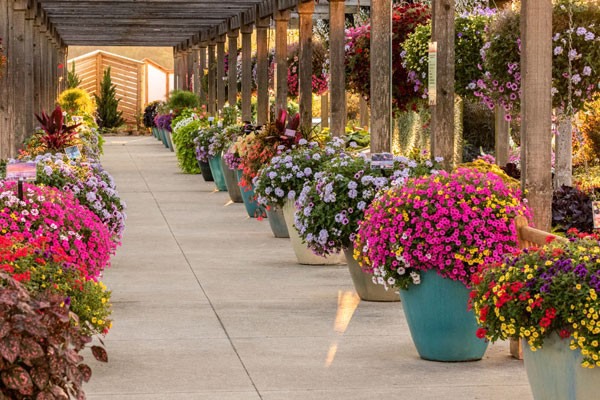
Choosing the right pot is as important as the combo itself, and most plants look great in a blue, neutral, stone or terra cotta pot like those pictured here in Four Star’s Display Gardens.
He generally tries to match a thriller with the height and width of its pot. “Be careful picking thrillers as some can get too big for a medium-sized pot, like Graceful Grasses King Tut Cyperus, most Salvia, Senorita Cleome and Helianthus,” he notes. “Try using thrillers in baskets and small pots, like delicate Gaura and Angelonia, or smaller tropical plants like Dracaena, Croton, Graceful Grasses Prince Tut Cyperus, ferns, Hippo Hypoestes and Heart to Heart Caladium.”
Four Star’s catalog lists vigor ratings for varieties, and that can be really useful when selecting plants for a combination, he says. “Vigorous plants can quickly outgrow their neighbors, so try to match the vigor ratings for all plants in a combination. Plants with strong vigor include Supertunia Vista Petunia, Dragon Wing Begonia, Lantana, Cyperus, ColorBlaze Solenostemon and Sweet Caroline Ipomoea.”
The popularity of shade combinations continues to grow, and designers in the industry are using a wide variety of shade-friendly plants as elements in everything from small baskets to large upright containers.
Consider the color
Color may be the most important consideration for many consumers buying combinations. Many experts suggest you study color trends such as Pantone’s Color of the Year and surveys of consumers’ color preferences as a planning aid.
Ian likes to start with the interaction of the plants. “Look for flowers/foliage that pull colors from each other. Bright colors are easy to accent with bright green, white or black. Use white or dark green to accent softer colors or make the third color pop!”
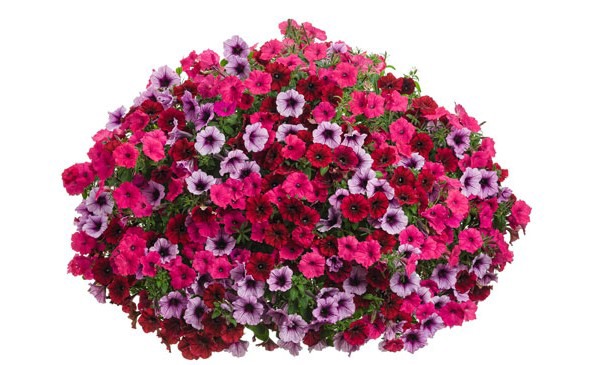
Top ten best seller Grand Traverse offers a mix of vigorous Supertunias in trending, saturated berry tones customers love.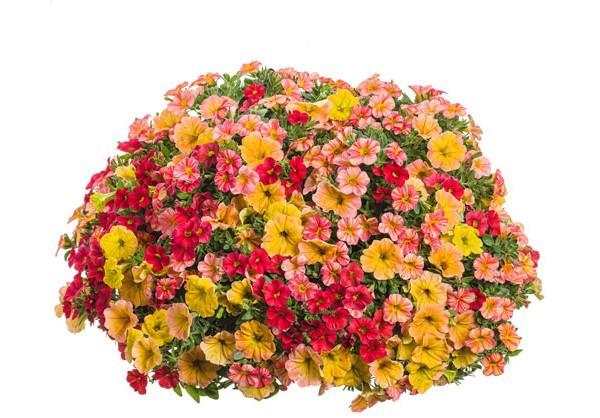
Popular combination Joy plays with color to great success: the softer colors of Supertunia Honey and Superbells Tropical Sunrise never look the same two days in a row, while the cheery red of Superbells Red pops in contrast.
He also suggests an easy method for coming up with successful color combinations. “Start with two plants of a similar color, then add a neutral and an accent color. For example, a blue-and-yellow pot with Unplugged So Blue Salvia, Superbells Blue Moon Punch Calibrachoa, Snow Princess Lobularia, and Luscious Lemonade Lantana.”
Ian also tries to create contrast, using brightness and saturation in more understated one-color combos. “I might mix softer Superbells Double Chiffon Calibrachoa and Bright Lights Double Moonglow Osteospermum with richer Garnet Lace Ipomoea and Goldilocks Rocks Bidens for a yellow combo that’s simple but effective.”
Foliage can be a designer’s friend, he notes. “Fun, variegated foliage can be just as exciting as flowers in a lot of places, and there are so many great options! Look to tropicals like Heart to Heart Caladium, Pegasus Begonia, Hedera, Colocasia, Hippo Hypoestes, ColorBlaze Solenostemon, Ipomoea and others.”
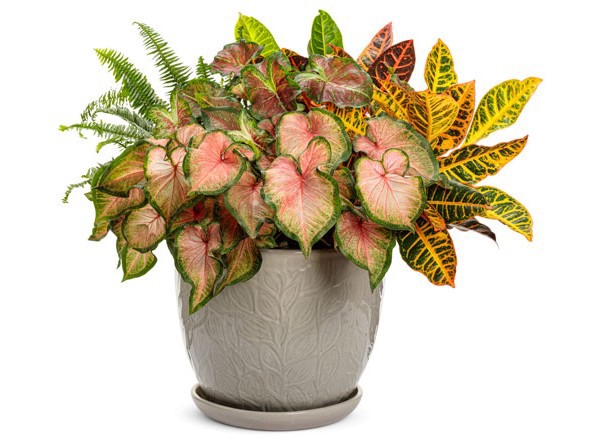
Foliage can be as exciting as flowers in a combo like Rhymes, which features new Heart to Heart Caladiums mixed with bright colors and varying textures.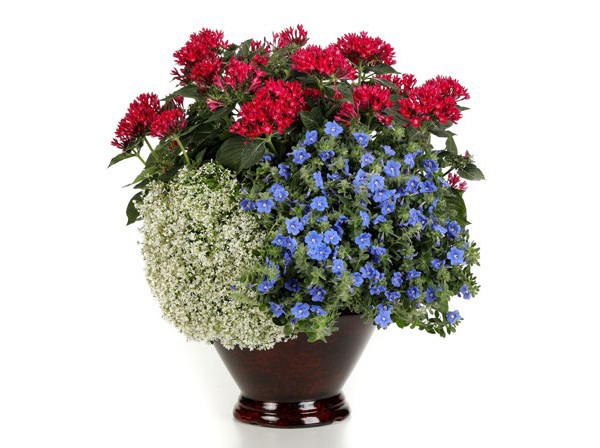
American Anthem proves that a familiar patriotic color combination can be made fresh again by finding new contrasts in texture among the most popular varieties.
If you want more ideas for color combinations that work, Ian suggests taking a look at color theory books or creating a collection of photos of combinations you have liked. “Try this: cut pictures of your favorite plants out of an old catalog to quickly arrange and try out new combos.”
For more information and tips on creating great combinations, click here.
For more informatio n:
n:
Four Star Greenhouse
734-654-6420
[email protected]
www.pwfourstar.com
